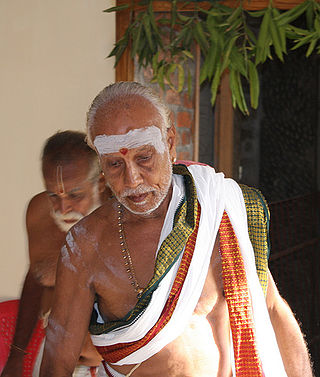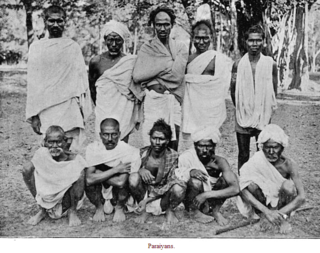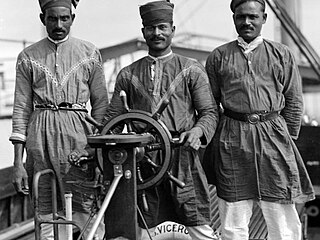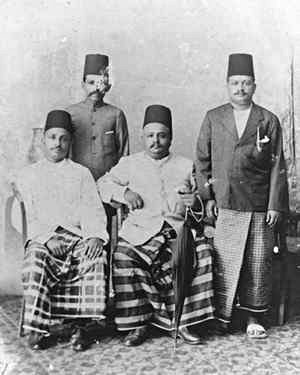
Iyers are an ethnoreligious community of Tamil-speaking Brahmins. Most Iyers are followers of the Advaita philosophy propounded by Adi Shankara and adhere to the Smarta tradition. This is in contrast to the Iyengar community, who are adherents of Sri Vaishnavism. The Iyers and the Iyengars are together referred to as Tamil Brahmins. The majority of Iyers reside in Tamil Nadu, India.

Tamil Muslims are Tamils who practise Islam. The community is 6 million in India, primarily in the state of Tamil Nadu where 90% of the Muslim community identified themselves as Tamil Muslims. In Tamil Nadu, the majority of Tamil-speaking Muslims belong to the Rowthers Community while other Muslims live in coastal Tamil Nadu. There is a substantial diaspora, particularly in Southeast Asia, which has seen their presence as early as the 13th century. In the late 20th century, the diaspora expanded to Western Europe, Persian Gulf and North America.

Paraiyar, Parayar or Maraiyar is a caste group found in the Indian states of Tamil Nadu and Kerala and in Sri Lanka.

The Marakkars are an Indic ethnic group with historical presence across the Indian Subcontinent and Indonesian Archipelago. Their contemporary populations are primarily concentrated in the Indian states of Kerala and Tamil Nadu, the Republic of Maldives, as well as the Western, Central, and Southern provinces of Sri Lanka. Within Southeast Asia, prominent Marakkar communities exist in Malaysia and Singapore.

Sri Lankan Moors are an ethnic minority group in Sri Lanka, comprising 9.3% of the country's total population. Most of them are native speakers of the Tamil language. The majority of Moors who are not native to the North and East also speak Sinhalese as a second language. They are predominantly followers of Islam. The Sri Lankan Muslim community is mostly divided between Sri Lankan Moors, Indian Moors, Sri Lankan Malays and Sri Lankan Bohras. These groups are differentiated by lineage, language, history, culture and traditions.

Islam arrived in Kerala, the Malayalam-speaking region in the south-western tip of India, through Middle Eastern merchants. The Indian coast has an ancient relation with West Asia and the Middle East, even during the pre-Islamic period.
Dravida Nadu is a name of a proposed sovereign state demanded by the Justice Party led by the founder of the self-respect movement, E.V. Ramasamy Periyar, and the Dravida Munnetra Kazhagam (DMK) led by C. N. Annadurai for the speakers of the Dravidian languages in South India.

The Velir were a royal house of minor dynastic kings and aristocratic chieftains in Tamilakam in the early historic period of South India. They had close relations with Chera, Chola and Pandya rulers through ruling and coronation rights. Medieval inscriptions and Sangam literature claim that they belong to the Yadu dynasty. Velir may refer to master of land.
The caste system among South Asian Christians often reflects stratification by sect, location, and the caste of their predecessors. There exists evidence to show that Christian individuals have mobility within their respective castes. But, in some cases, social inertia caused by their old traditions and biases against other castes remain, causing caste system to persist among South Asian Christians, to some extent. Christian priests, nuns, Dalits and similar groups are found in India, Pakistan, Bangladesh, and Nepal.
Labbay, are a Tamil Muslim trading community in southern India found throughout the southern Indian states of Tamil Nadu, Karnataka, Kerala and Andhra Pradesh. The Labbay are a subgroup within the Tamil Muslim community.
Podakkudi is a village in Thiruvarur district in the South Indian state of Tamil Nadu. The town is located at a distance of 20 km (12 mi) from the district headquarters Thiruvarur and 272 km (169 mi) from the state capital Chennai. Podakkudi is known for the Big Pallivasal, a prominent Islamic shrine. Nearby town is Koothanallur and the nearby villages are Atthikadai and Budamangalam.
Atheism and agnosticism have a long history in India and flourish within the Śramaṇa movement. Indian religions like Jainism, Hinduism and Buddhism consider atheism to be acceptable. Doubt has been ingrained even in Indian spiritual culture.

P. Dawood Shah was a Tamil enthusiast and scholar, activist and a gold medalist from Madurai Tamil Sangam. He also known as "Kamba Ramayana Sahib".

M. Muhammad Ismail was an Indian politician and social worker from southern Indian state Tamil Nadu. he was a founder of the Indian Union Muslim League party after the partition of British India. He was popularly known in Tamil Nadu and Kerala as the "Quaid-e-Millat". Ismail was a member of Madras Legislative Assembly and Leader of the Opposition (1946—52). He was also a member (1948—50) of the Constituent Assembly, the drafting body of the constitution of India. He was also a member of Rajya Sabha (1952—58) and Lok Sabha.
Chakkala Nair, also known as Vattakkat Nair, and Vaniya Nair is one of the intermediate subcastes of the Nair community. They are distributed throughout Kerala. In Travancore, they are known as Chakkala, while in Cochin and Malabar they are Vattakattu and In the extreme north of Malabar they are called Vaniya

Koothanallur is a town in Tiruvarur district in the South Indian state of Tamil Nadu. The town is located at a distance of 20 km (12 mi) from the district headquarters Tiruvarur and 350 km (220 mi) from the state capital Chennai.

Aranjanam / Araijan Kodi is a girdle-like ornament for the waist, worn around the waist by many south Indian adults and children. It is usually made of gold or silver, sometimes it may also be a red or black thread tied around the waist. Aranjanam are common among women and men in India south India. A traditional practice being followed even today by many women and men, it is believed wearing Aranjanam is considered as protection from negative energy. In Kerala, almost all newborns irrespective of the religious affiliation get a waist chain. Although many boys generally abandon waist chains during their teenage years, but most girls continue to wear waist chains as adults. In Tamil Nadu, it is known as 'Araijan Kodi' and 'Aranjana Charadu' in Kerala, It is made of gold, silver, or thick thread in red or black and wears it under clothes and usually keeps it on all the time, even when nude. Aranjanam can also fasten the cloth on the waist, similar to women using it to secure the folds of a sari. Some parents also believe that it will safeguard against evil spirits. Although in India, many women and men continue to wear them as adults as well. A follower of Shiva is expected to wear a chain, with Rudrakshas strung in a white chain with one hundred beads, around the waist. In Lakshadweep a silver thread is worn by both men and women.
Sri Lankan Paraiyar is a Tamil caste found in northern and eastern Sri Lanka. They are traditional parai-drummers who were also involved in weaving and scavenging.
Seera Puranam is a 17th-century Tamil literary work written by the Rowther Tamil poet Umaru Pulavar, which narrates the life and teachings of the Islamic prophet Muhammad. It is regarded as a significant contribution to Tamil Islamic literature and is known for its poetic rendition of religious themes. It is considered one of the earliest Islamic literary works in Tamil, exemplifying the synthesis of Tamil and Islamic literary traditions that characterized South Indian literature during the medieval period.













